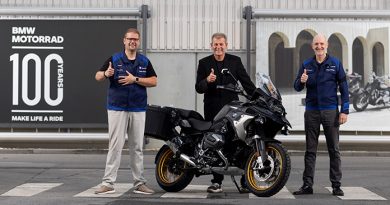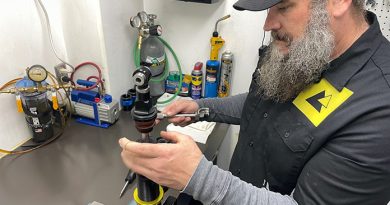Rider Comparo: 2024 CFMOTO 800NK vs. Suzuki GSX-8S
Back in the ’70s, Cycle magazine coined the term “Universal Japanese Motorcycle” to refer to the proliferation of standard bikes built by the Japanese Big Four that adhered to the same formula: air‑cooled inline‑Fours with tubular cradle frames, disc front brakes, telescopic forks, and dual rear shocks.
Much has changed in the last five decades, but manufacturers still stick to tried‑and‑true formulas when designing motorcycles. These days, regardless of where bikes hail from, there has been a convergence in the middleweight class on parallel‑Twin engines because they are cost‑effective to produce, easy to package within a frame, and flexible in terms of tuning. Also known as vertical Twins because the two side‑by‑side cylinders stand upright, modern versions typically have liquid cooling, fuel injection, and a 270‑degree crankshaft that produces a V‑Twin‑like rumble.
Last year, Suzuki, a veteran of the UJM wars, introduced a liquid‑cooled 776cc parallel‑Twin that powered two new models: the GSX‑8S naked sportbike and V‑Strom 800DE adventure bike. The engine has DOHC, 4 valves per cylinder, a 270‑degree crank, throttle‑by‑wire, and Suzuki’s patented Cross Balancer system, which minimizes vibration. The GSX‑8S is equipped with several Suzuki Intelligent Ride System electronic rider aids, including throttle response modes (Active, Basic, and Comfort), multi‑mode traction control (1, 2, 3, and Off), an up/down quickshifter, Easy Start, and Low RPM Assist.
Chinese manufacturer CFMOTO entered the U.S. motorcycle market in 2022 and has expanded its lineup to 11 models for 2024. One of its newest is the 800NK, a naked sportbike powered by a liquid‑cooled 799cc parallel‑Twin that’s a previous‑gen version of the KTM 790 engine, which CFMOTO now builds under a partnership agreement. Similar to Suzuki’s modular approach, the same engine is found in CFMOTO’s Ibex 800 adventure bikes. On the tech front, the 800NK has throttle‑by‑wire, throttle response modes (Sport, Street, and Rain), and cruise control but no traction control or quickshifter.
Those looking for an affordable, streetfighter‑styled motorcycle would likely cross‑shop these two bikes, especially since there’s just a $500 delta between their MSRPs: $8,999 for the Suzuki and $8,499 for the CFMOTO. To suss out their differences, we tested them back‑to‑back on local freeways and backroads and had our friend John Ethell at Jett Tuning run them on a Dynojet dynamometer.
CFMOTO 800NK vs. Suzuki GSX8S: Wonder Twin Powers, Activate!
Despite just a 23cc difference in displacement between the CFMOTO and Suzuki, there’s a significant difference in engine output. Both Twins rev out to nearly 10,000 rpm, and their dyno curves show fairly linear increases in power and flat torque curves. Past 6,000 rpm, their curves begin to diverge, with the CFMOTO climbing to 93.4 hp at 9,400 rpm while the Suzuki levels out at 75.9 hp at 8,300 rpm. Torque figures are closer, but the 800NK still has the advantage in the upper rev range, maxing out at 57.1 lb‑ft at 6,600 rpm compared to 53.3 lb‑ft at 6,700 rpm on the GSX‑8S.
The CFMOTO also has a lower curb weight, giving it a higher power‑to‑weight ratio. It weighs 410 lb with its 4.0‑gallon tank full, whereas the Suzuki weighs 445 lb with 3.7 gallons in its tank.
Differences in power and weight aren’t readily apparent at lower rpm and around‑town speeds, but the Suzuki feels more refined. The GSX‑8S starts easily when cold, idles smoothly, and has spot‑on fueling and throttle response. The 800NK, on the other hand, is slow to warm up, idles like it’s in a bad mood, and exhibits some hesitation when making throttle adjustments between 4,000 to 6,000 rpm, which corresponds to a dip in the horsepower and torque curves.
Above 6,000 rpm, however, the CFMOTO finds its groove, responding cleanly and directly to throttle inputs and making its power and weight advantages readily apparent. It flicks back and forth through tight corners more easily than the Suzuki, and a twist of the wrist catapults the 800NK ahead more rapidly than the GSX‑8S, which falls flat in the upper rev range. Although sound doesn’t necessarily affect performance, it does tap into our emotions. The CFMOTO’s more aggressive exhaust note makes for a more engaging riding experience without being too loud.
GEAR UP
Helmet: Shoei Neotec 2
Jacket: Vanson Sportrider Lightning
Gloves: Alpinestars Halo
Pants: Alpinestars Copper V2 Denim
Boots: Sidi Meta Riding Shoes
There’s also some daylight between these bikes in terms of shifting. Both are equipped with 6‑speed transmissions with cable‑actuated slip/assist clutches. Neither bike requires much effort to change gears, but the Suzuki’s gearbox is noticeably smoother, and it’s aided by the convenience of a quickshifter. The CFMOTO has an adjustable clutch lever, but the Suzuki does not.
See all of Rider‘s CFMOTO coverage here.
More Bounce to the Ounce
When manufacturers aim for aggressive price targets, one of the most common places to cut costs is with the suspension, particularly in terms of adjustability. Both CFMOTO and Suzuki sourced their components from Japanese suspension maker KYB, and both bikes have inverted forks (43mm on the CFMOTO, 41mm on the Suzuki) and rear monoshocks. The only adjustability on the GSX‑8S is rear preload, but the 800NK offers full adjustability on the fork and rebound and preload adjustability on the shock. Ride quality between the two is fairly similar, with their damping rates calibrated for general use rather than the tautness of more aggressive sportbikes, but the CFMOTO allows riders to dial in their preferences front and rear.
The CFMOTO has a slight edge in terms of braking. With components sourced from J.Juan, a Spanish subsidiary of Brembo, the 800NK has a pair of 4‑piston radial front calipers pinching 320mm discs, a 2‑piston rear caliper pinching a 260mm disc, a radial‑pump front master cylinder, and steel‑braided lines. The 800NK’s brakes provide strong, consistent power with good feedback from the adjustable front lever, but they could use more initial bite.
The Suzuki wears Nissin brakes, with dual 4‑piston radial front calipers squeezing 310mm discs, a 1‑piston rear caliper squeezing a 240mm disc, an axial‑pump front master cylinder, and rubber lines. Stopping power is decent, but the Suzuki’s brakes feel more numb and provide less feedback than the CFMOTO’s. ABS is standard on both bikes.
GEAR UP
Helmet: Schuberth S3
Jacket: Joe Rocket Egomaniac
Gloves: Joe Rocket Sector
Pants: Joe Rocket Anthem Jeans
Boots: Joe Rocket Outbreak
Sit Up and Be Somebody
The 800NK and GSX‑8S are compact machines with short wheelbases, narrow waistlines, and sporty chassis geometry. Both have steel frames, steel subframes, cast‑aluminum swingarms, and tapered aluminum handlebars. From the cockpit, the Suzuki almost disappears beneath the rider thanks to its svelte tank, 1.7-inch narrower handlebar, and slender (but 0.4 inch taller) seat. The CFMOTO’s tank and bodywork flare out more, and its handlebar is wider, giving it more visual presence from the saddle. Its seat is also wider at the back and has thicker, more comfortable foam.
As streetfighters, these bikes lend themselves to an aggressive riding style, but they’re comfortable enough for everyday riding or commuting. Their handlebars’ bends and risers allow for an upright seating position, and their footpegs are placed high enough for good cornering clearance but low enough for adequate legroom.
When you exit the highway and find your way to a winding backroad, they are more than happy to display their athleticism. Both roll on 17‑inch cast wheels with 120/70 front and 180/55 rear tire sizes, and their radials – Maxxis Supermaxx ST on the CFMOTO, Dunlop Roadsmart 2 on the Suzuki – provide neutral handling and decent grip. With its additional steering leverage and 35‑lb weight advantage, the CFMOTO is more agile than the Suzuki but not by much.
See all of Rider‘s Suzuki coverage here.
CFMOTO 800NK vs. Suzuki GSX8S: Devil in the Details
In some ways, these are two evenly matched motorcycles, while in others, they diverge. One is built by a well‑established Japanese brand that has been building motorcycles since the early 1950s and selling them in America since 1963. The other is built by an upstart Chinese company that has been building motorcycles only since 2000 but has grown rapidly and not only builds its own engines and motorcycles but also builds them for KTM, Europe’s largest manufacturer.
Although the Suzuki GSX‑8S was introduced in 2023 as a new model with a new engine, it feels very refined. It has the build quality and fit and finish one expects from one of the Big Four Japanese manufacturers, and its engine, electronics, and chassis work together harmoniously. The GSX‑8S costs $500 more than the 800NK, but it has standard features that the CFMOTO lacks, such as traction control and an up/down quickshifter. Its bright TFT instrument panel uses a larger, thicker font and is easier to read in all conditions than the one on the 800NK.
As the new kid on the block looking to build trust in the market, CFMOTO’s value proposition is to provide more bang for the buck. For the 800NK, that starts with the tried‑and‑true KTM 790 engine that delivers an additional 17.5 hp and 3.8 lb‑ft of torque over the GSX‑8S motor. It continues with a 35‑lb lower curb weight, suspension with more adjustability, higher‑spec brakes, and features like cruise control and smartphone connectivity. Not only is the base price lower, but it comes with an additional year of warranty coverage. But it also feels rougher around the edges, particularly regarding its low‑rpm fueling.
If you’re an experienced rider who wants a light, powerful, somewhat rowdy streetfighter and can live without traction control and a quickshifter, you’ll want the CFMOTO 800NK. But if you’re someone who prioritizes smoothness and refinement over power, or if you’re a newer rider, the Suzuki GSX‑8S is for you.
Spec Comparo: 2024 CFMOTO 800NK vs. 2024 Suzuki GSX-8S
Base Price: $8,499 (CFMOTO) — $8,999 (Suzuki)
Warranty: 2 yrs., unltd. miles — 1 yr., unltd. miles
Website: CFMOTOusa.com — SuzukiCycles.com
Engine Type: Liquid‑cooled, transverse parallel‑Twin, DOHC w/ 4 valves per cyl. — Liquid-cooled, transverse parallel-Twin, DOHC w/ 4 valves per cyl.
Displacement: 799cc — 776cc
Bore x Stroke: 88 x 65.7mm — 84.0 x 70.0mm
Horsepower (rear-wheel dyno): 93.4 hp @ 9,400 rpm — 75.9 hp @ 8,300 rpm
Torque (rear-wheel dyno): 57.1 lb‑ft @ 6,600 rpm — 53.3 lb‑ft @ 6,700 rpm
Transmission: 6‑speed, cable‑actuated slip/assist wet clutch — 6‑speed, cable‑actuated slip/assist wet clutch
Final Drive: Chain — Chain
Wheelbase: 57.8 in. — 57.7 in.
Rake/Trail: 24 degrees/3.8 in. — 25 degrees/4.1 in.
Seat Height: 31.5 in. — 31.9 in.
Wet Weight: 410 lb — 445 lb
Fuel Capacity: 4.0 gal. — 3.7 gal.
Fuel Consumption: 42.9 mpg — 48.7 mpg
The post Rider Comparo: 2024 CFMOTO 800NK vs. Suzuki GSX-8S appeared first on Rider Magazine.




